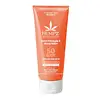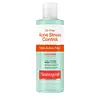What's inside
What's inside
 Key Ingredients
Key Ingredients

 Benefits
Benefits

 Concerns
Concerns

 Ingredients Side-by-side
Ingredients Side-by-side

Butyl Methoxydibenzoylmethane 3%
UV AbsorberHomosalate 10%
Skin ConditioningEthylhexyl Salicylate 5%
UV AbsorberOctocrylene 10%
UV AbsorberWater
Skin ConditioningCoco-Caprylate
EmollientPropanediol
SolventCaprylic/Capric Triglyceride
MaskingGlycerin
HumectantEthylhexyl Olivate
Skin ConditioningVp/Eicosene Copolymer
Cannabis Sativa Seed Oil
EmollientButyrospermum Parkii Butter
Skin ConditioningCocos Nucifera Oil
MaskingPersea Gratissima Oil
Skin ConditioningAloe Barbadensis Leaf Juice
Skin ConditioningAnanas Sativus Fruit Extract
Skin ConditioningCucumis Melo Fruit Extract
Skin ConditioningArgania Spinosa Kernel Oil
EmollientSqualane
EmollientHelianthus Annuus Seed Oil
EmollientAscorbic Acid
AntioxidantCitric Acid
BufferingDiethylhexyl Syringylidenemalonate
Skin ProtectingCetearyl Alcohol
EmollientGlyceryl Stearate
EmollientPEG-100 Stearate
Phenoxyethanol
PreservativePolyester-7
Skin ConditioningCetearyl Olivate
Stearic Acid
CleansingNeopentyl Glycol Diheptanoate
EmollientSorbitan Olivate
EmulsifyingParfum
MaskingChlorphenesin
AntimicrobialCarbomer
Emulsion StabilisingTrisodium Ethylenediamine Disuccinate
Ethylhexylglycerin
Skin ConditioningLimonene
PerfumingTocopheryl Acetate
AntioxidantAminomethyl Propanol
BufferingBenzyl Benzoate
AntimicrobialLinalool
PerfumingBisabolol
MaskingTocopherol
AntioxidantPanthenol
Skin ConditioningPotassium Sorbate
PreservativeSodium Benzoate
MaskingButyl Methoxydibenzoylmethane 3%, Homosalate 10%, Ethylhexyl Salicylate 5%, Octocrylene 10%, Water, Coco-Caprylate, Propanediol, Caprylic/Capric Triglyceride, Glycerin, Ethylhexyl Olivate, Vp/Eicosene Copolymer, Cannabis Sativa Seed Oil, Butyrospermum Parkii Butter, Cocos Nucifera Oil, Persea Gratissima Oil, Aloe Barbadensis Leaf Juice, Ananas Sativus Fruit Extract, Cucumis Melo Fruit Extract, Argania Spinosa Kernel Oil, Squalane, Helianthus Annuus Seed Oil, Ascorbic Acid, Citric Acid, Diethylhexyl Syringylidenemalonate, Cetearyl Alcohol, Glyceryl Stearate, PEG-100 Stearate, Phenoxyethanol, Polyester-7, Cetearyl Olivate, Stearic Acid, Neopentyl Glycol Diheptanoate, Sorbitan Olivate, Parfum, Chlorphenesin, Carbomer, Trisodium Ethylenediamine Disuccinate, Ethylhexylglycerin, Limonene, Tocopheryl Acetate, Aminomethyl Propanol, Benzyl Benzoate, Linalool, Bisabolol, Tocopherol, Panthenol, Potassium Sorbate, Sodium Benzoate
Salicylic Acid
MaskingWater
Skin ConditioningAlcohol Denat.
AntimicrobialButylene Glycol
HumectantPPG-5-Ceteth-20
EmulsifyingC12-15 Alkyl Lactate
EmollientParfum
MaskingSodium Citrate
BufferingCocamidopropyl Pg-Dimonium Chloride Phosphate
PEG/PPG-20/6 Dimethicone
EmulsifyingSodium Hydroxide
BufferingBenzalkonium Chloride
AntimicrobialCetyl Lactate
EmollientSodium Benzotriazolyl Butylphenol Sulfonate
UV AbsorberDisodium EDTA
Propylene Glycol
HumectantCucumis Sativus Fruit Extract
EmollientCamellia Oleifera Leaf Extract
AstringentBlue 1 Lake
Cosmetic ColorantCamellia Sinensis Leaf Extract
AntimicrobialCI 19140
Cosmetic ColorantSalicylic Acid, Water, Alcohol Denat., Butylene Glycol, PPG-5-Ceteth-20, C12-15 Alkyl Lactate, Parfum, Sodium Citrate, Cocamidopropyl Pg-Dimonium Chloride Phosphate, PEG/PPG-20/6 Dimethicone, Sodium Hydroxide, Benzalkonium Chloride, Cetyl Lactate, Sodium Benzotriazolyl Butylphenol Sulfonate, Disodium EDTA, Propylene Glycol, Cucumis Sativus Fruit Extract, Camellia Oleifera Leaf Extract, Blue 1 Lake, Camellia Sinensis Leaf Extract, CI 19140
 Reviews
Reviews

Ingredients Explained
These ingredients are found in both products.
Ingredients higher up in an ingredient list are typically present in a larger amount.
Parfum is a catch-all term for an ingredient or more that is used to give a scent to products.
Also called "fragrance", this ingredient can be a blend of hundreds of chemicals or plant oils. This means every product with "fragrance" or "parfum" in the ingredients list is a different mixture.
For instance, Habanolide is a proprietary trade name for a specific aroma chemical. When used as a fragrance ingredient in cosmetics, most aroma chemicals fall under the broad labeling category of “FRAGRANCE” or “PARFUM” according to EU and US regulations.
The term 'parfum' or 'fragrance' is not regulated in many countries. In many cases, it is up to the brand to define this term.
For instance, many brands choose to label themselves as "fragrance-free" because they are not using synthetic fragrances. However, their products may still contain ingredients such as essential oils that are considered a fragrance by INCI standards.
One example is Calendula flower extract. Calendula is an essential oil that still imparts a scent or 'fragrance'.
Depending on the blend, the ingredients in the mixture can cause allergies and sensitivities on the skin. Some ingredients that are known EU allergens include linalool and citronellol.
Parfum can also be used to mask or cover an unpleasant scent.
The bottom line is: not all fragrances/parfum/ingredients are created equally. If you are worried about fragrances, we recommend taking a closer look at an ingredient. And of course, we always recommend speaking with a professional.
Learn more about ParfumWater. It's the most common cosmetic ingredient of all. You'll usually see it at the top of ingredient lists, meaning that it makes up the largest part of the product.
So why is it so popular? Water most often acts as a solvent - this means that it helps dissolve other ingredients into the formulation.
You'll also recognize water as that liquid we all need to stay alive. If you see this, drink a glass of water. Stay hydrated!
Learn more about Water